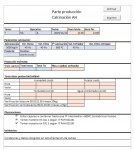HectorGips
New member
- Local time
- Today, 12:04
- Joined
- Feb 13, 2020
- Messages
- 20
Buenos días to everybody.
I'm preparing a db for the production department of my factory, it's an aggregates and gravel factory.
Its progress it's now over 75%, but I'm beginning to think that I missed the table design and I'm in time yet to change it.
So:
-In the factory there are four working areas: milling, calcination, micronizing and bagging.
-In the db (with forms) you create every day the working order for every shift and area (setting operators, materials, production expected, etc.).
-Once the working day is over, the same db is filled with production results (pallets, bags, incidents, etc.)
-The tracking id (but not necessarily the key id) is the date and shift in this format (20200318M for morning, 20200318N for night and so on).
-Not all the areas work allways. One week might works just milling, or one morning work all the areas but by night just works bagging. They're independents.
So for this I created just one table. In the beginning was enough. A record for every shift, three records a day. I know it's not ideal because several fields remain empty when there isn't work in any of the areas.
But recently the quality guy came with about 100 new fields for the processing quality.
I'm thinking about divide by four the table, one for area. Or one table for production, another for quality records.
But at this point I don't want to miss again, and I'd like to prepare a db that can stand over time.
I don't mind to begin from scratch, or re-arrange my current db, I don't mind the hard work.
So I need your help in order to get the design that fits best this task.
I attach a recent version of the db, yet incomplete, but you can see whats going on.
http://drive.google.com/file/d/1JE2HfZefdsg_YLKkG9DPOcYD1ixgrbzG/view?usp=sharing
Many thanks and regards.
I'm preparing a db for the production department of my factory, it's an aggregates and gravel factory.
Its progress it's now over 75%, but I'm beginning to think that I missed the table design and I'm in time yet to change it.
So:
-In the factory there are four working areas: milling, calcination, micronizing and bagging.
-In the db (with forms) you create every day the working order for every shift and area (setting operators, materials, production expected, etc.).
-Once the working day is over, the same db is filled with production results (pallets, bags, incidents, etc.)
-The tracking id (but not necessarily the key id) is the date and shift in this format (20200318M for morning, 20200318N for night and so on).
-Not all the areas work allways. One week might works just milling, or one morning work all the areas but by night just works bagging. They're independents.
So for this I created just one table. In the beginning was enough. A record for every shift, three records a day. I know it's not ideal because several fields remain empty when there isn't work in any of the areas.
But recently the quality guy came with about 100 new fields for the processing quality.
I'm thinking about divide by four the table, one for area. Or one table for production, another for quality records.
But at this point I don't want to miss again, and I'd like to prepare a db that can stand over time.
I don't mind to begin from scratch, or re-arrange my current db, I don't mind the hard work.
So I need your help in order to get the design that fits best this task.
I attach a recent version of the db, yet incomplete, but you can see whats going on.
http://drive.google.com/file/d/1JE2HfZefdsg_YLKkG9DPOcYD1ixgrbzG/view?usp=sharing
Many thanks and regards.









